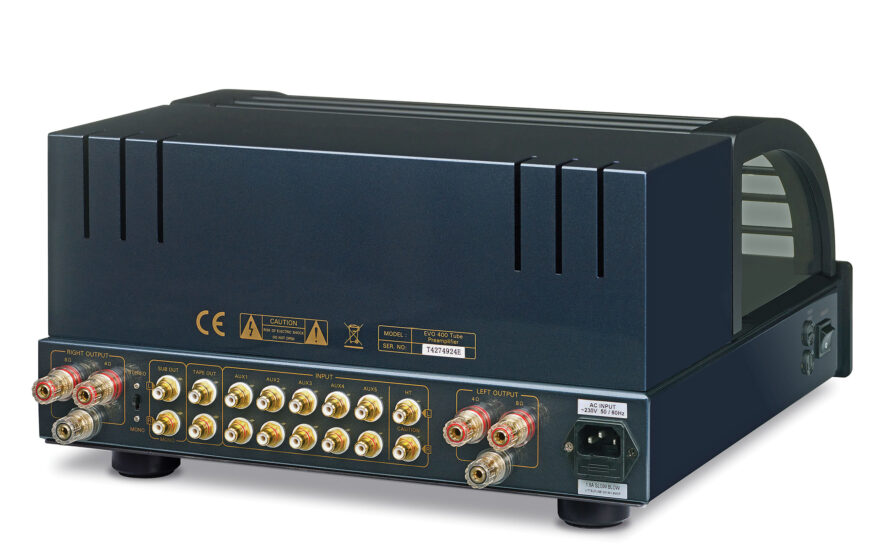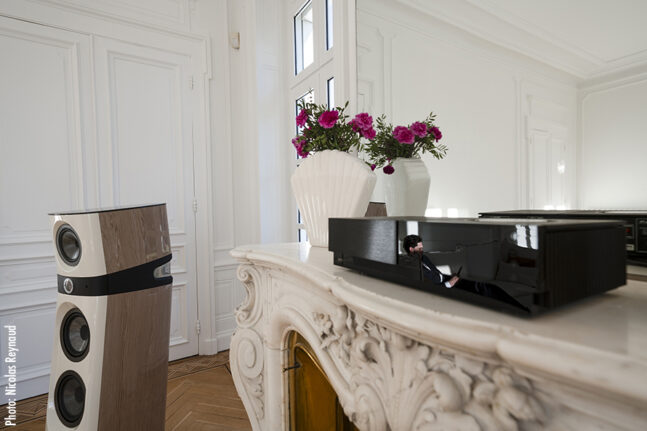Musical Personality, Interesting Criteria And Technical Strength!
If you’ve been interested in tube amplification over the past decade, then you’ve likely come across PrimaLuna. The company’s name, PrimaLuna, is an Italian name, yet it’s the Netherlands that the founder and the company has its origins. Look no further than PrimaLuna’s European website (https://www.primaluna.nl/) to find the company’s story, in which it’s revealed that the company name was inspired by the founder’s grandmother’s nickname for her husband… whom she affectionately called Little Moon. Herman had this in mind when he came up with PrimaLuna, which translates to English as First Moon…and that too is why PrimaLuna’s logo is, what it is.
It’s been sometime since I’ve had the chance to listen to a PrimaLuna product in my own home, the last time was back in 2020 when I evaluated a PrimaLuna EVO 200 integrated amplifier. I was living in Dublin, Ireland at the time and that integrated amplifier was the source of many enthralling and pleasurable hours of music listening. With such fond memories of my Dublin listening sessions, I reached out to PrimaLuna, to see if I could now put my ears to their flagship integrated amplifier… enter the EVO 400, the subject of this review.
PrimaLuna, as I just mentioned, is based out of the Netherlands, and was first established back in 2003, with the release of two tube integrated amplifiers – the ProLogue One and ProLogue Two. These initial products aimed to deliver the highest value possible; you might say the most for the least. To meet that objective, PrimaLuna uses, what they refer to as, ‘Western design and marketing, combined with Far East manufacturing under European control and Dutch-after-sales-service’ and this is just what the sticker on the bottom of the EVO 400 implies i.e.: ‘Engineered In Europe – Made in PRC’. This has been a most successful approach for the company, establishing PrimaLuna firmly in the market, as a high-end audio product manufacturer, providing real world prices. And the many accolades PrimaLuna has received from audio publications and customers alike, only further testifies to this success.
Within PrimaLuna’s EVO Series, launched in 2019, we do find a model hierarchy – based on performance and price. The four levels of performance/price are identifiable by the model number, from: 100 up to 400, the highest offering the greatest performance at the highest price point. PrimaLuna is one of the few and far between audio product manufacturers that continue today to offer both hand-assembled and point-to-point wiring for all their products. PrimaLuna distinguishes their integrated amplifier products from their competitors in a few ways, which I’ll highlight now.

Toroidal Transformers
PrimaLuna makes clear that the most important and expensive parts of a tube amplifier are the output transformers. Like few other companies, PrimaLuna designs and winds its own power and output transformers and use all toroidal transformers, given their lower noise. The transformers area also potted in oversized metal housings that are filled with non-microphonic resin to minimize noise and provide moisture resistance, adding to longevity. PrimaLuna clearly takes pride in the transformers they use, which allow their amps to deliver the highest bass control and quality.
Adaptive AutoBias / Extended Tube Life
Most manufacturers of tube amplifiers, especially those with high wattage ratings achieve this with higher voltage through the tubes but that drastically reduces tube reliability and life. PrimaLuna, ensures just the necessary voltage is run through the tube to optimize performance. PrimaLuna’s proprietary true Adaptive AudioBias uses sensors to constantly monitor performance of each power tube, and adjust automatically in real time, instantly adapting and keeping the tubes within their operating tolerances. This yields very low distortion and dramatically extended tube life (up to 3 000 hours!) together with enhanced performance most recognized in power reserves, transparency and bass authority and control. Bad tube indicators LEDs are provided for each power tube and auto-protection guards the circuits from catastrophic tube failure. Adaptive AutoBias also allows for an incredibly broad variety of tubes to be used, EL34 through to even a KT150.
Triode / Ultra-Linear Switching, on-the-fly
Though Triode amplifiers are praised for their warmer, fuller, and easy to settle into sound, it is Ultra-linear amplification that provides greater frequency bandwidth and greater power, with larger dynamic swings from soft to loud. The PrimaLuna EVO 300 and 400 integrated amplifiers offer both triode and ultra-linear, switchable remotely on-the-fly, at just the push of a button.
Point-to-Point Wiring
Though very rare in today’s consumer electronics industry, given the higher cost and needed hand assembly, PrimaLuna integrated amplifier circuits are all point to point wired, across the entire audio signal path. The EVO 300 and EVO 400 models also use Swiss silver-plated OFC cable with a Teflon dielectric. Ceramic tube sockets secured to ventilated frames made of steel, bolted to the chassis and hand-wired using heavy gauge cable are a defining feature.
Top Quality Parts
PrimaLuna sources very high-quality parts, with the EVO 400 having Takamisawa relays for its inputs, an Alps Blue Velvet volume potentiometer, Nichicon audio capacitors and Takman resistors, including carbon in strategic locations. PrimaLuna also employs an AC Offset Killer that prevents mechanical hum due to line power, removing DC from the line power and lowering transformer noise.
Transformer-Coupled Subwoofer Output
Both the EVO 300 and 400 integrated amplifiers provide a transformer coupled subwoofer output, which is switchable from stereo to mono. Run off the loudspeaker taps of the wide-bandwidth output transformers to a voltage-divider network, it ensures a connected subwoofer gets the same signal ‘flavour’ that the loudspeaker receive for maximum coherence and increased dynamics.
Unique Headphone Amplifier
The built-in headphone amplifier is not discrete nor an op-amp design but rather, emulates some of the most expensive headphone amplifier designs around by utilizing a voltage divider network that lowers the direct amplifier output to a useable level for headphones. Unique to PrimaLuna is its ability to switch on the fly, at the press of a button, between Triode and Ultra-linear.
Let’s have a closer look at the unit
The EVO 400 comes equipped with six 12AU7 tubes in the preamp section and eight EL34 tubes in the output section. It provides through this tube complement, 38 W x 2 (Triode) and 70 W x 2 (Ultra-linear) into 8Ω @ 1 % THD. Five stereo RCA inputs and 1 stereo RCA HT bypass are provided, along with, outputs that include: 4Ω and 8Ω speaker taps (5-way posts), an RCA stereo / mono Subwoofer output, stereo RCA tape output and a ¼” headphone jack, as well, an optional MM phono stage can be added – my sample did not include this. The EVO 400 weighs in at a hefty 68.6 lbs.
There are two finish options, silver or black for the faceplate, while the main chassis is slate metallic gloss grey, in either case. A black cast aluminum valve cage with glass side-inserts rounds out the neat and attractive profile of this amplifier. Build is very robust and unfaultable, and the same goes for the paint quality. Switches and controls have solid positive feel, using relays for the input selector. The IR remote is of billet aluminum with metal buttons and is both attractive and built to last a generation and then some. Nothing about the EVO 400 suggest it is anything but a true high-end valve amplifier, irrespective of its attainable price$ 5,595 US. The overall appearance is austere with a shot of personality that will surely instill pride in its owner.
Equipment used for the review
I reviewed the PrimaLuna EVO 400 with my Bryston BR20 as the digital source (DAC + streamer) with music streamed from Qobuz & Tidal HiFi, as well as CD, via my Rega Apollo, as a transport. For vinyl, my VPI Scout 1.1 turntable with Dynavector 10×5 HO-MC and Gold Note PH10 / PSU10 combo. The loudspeakers used were primarily my Dynaudio C2 Signatures.
Let’s see what it can do
First up was a comparison to my Rega Elex-R. The Elex-R is a remarkable sounding product, even more so, given its modest price. The PrimaLuna EVO 400 is a significantly more expensive integrated amplifier, about three times the price. The Elex-R is built around a quasi-MOSFET amplification circuit, while the EVO 400 is a full tube design. Comparing their sound, the PrimaLuna was clearly able to reveal more details and add nuance, exposing additional harmonic colours and musical textures. Though the Elex-R has a full and commanding sound, it sounded a little thick and opaque when compared with the EVO 400. The PrimaLuna while delivering scale, solid bass impact and concussive dynamics, sounded more defined and articulate and offered up more midrange realism, along with an endearing top end brilliance and finesse.
How does it do musicality wise?
It’s all about the bass, right? The PrimaLuna EVO 400 is an integrated amplifier to break any preconception one might have about tube amplifiers providing compromised bass. Though the EVO 400 is a tube amplifier, running EL34 power tubes out-of-the-box, it would be wrong to presume it can’t deliver great bass performance. Listening to one of my favorite electronic bass tracks, Loveless, by Lo Moon, the subterranean deep bass and dynamic swings were handled with unwavering control through the EVO 400. The sound was crazy rich and full, while also very dynamic, the electronic bass notes having wonderful depth, along with their visceral growl. Bass was tactile, articulate with a full sense of weight. While focused on the bass, I couldn’t ignore the juxtaposition of guitar sweetness as well as the ethereal quality of the vocals, with their accompanying reverb.
On the track Dark Black by Kristrina Train, the EVO 400 was wonderful with rendering Kristina’s delicate, yet powerful phasing and vocalization. There was precision in the vocals coupled with a most effective capture of the reverb in the recording, I found this also the case with Zöe Kratvitz song, Don’t from Big Little Lies. Here, the EVO 400 demonstrated its ability to separate massed voices, separately calling out a half dozen vocalists and separating them in space from Zöe lead vocals.
Next up was the track, Keep the Wolves Away by Uncle Lucius. The low percussion hits were cavernous, the strikes rolling echoes taking their time to naturally decay, all the while maintaining their audible composure. There was a dead weight solidity to the bass, manifesting in presence, scale and dynamic capacity. Moving to a track like Black Crow from Angus and Julia Stone, the bass guitar plucks were surprisingly impactful and dense and convinced me that with the EVO 400, PrimaLuna has achieved a goldilocks balance between bass articulation and weight that will undoubtedly satisfy the music lover and analytic.
So, how’s the midrange on the PrimaLuna EVO 400 you might ask? Now, well designed tube amplifiers, will typically deliver a very pleasing midrange. When the design is good, then the tubes add an inherent smoothing, sweetening and holographic effect. That doesn’t mean that all tube amplifiers will deliver midrange beauty; the lesser ones can sound vague, opaque, and fuzzy, as if lacking focus and essential detail, which sounds unengaging and boring. In this regard, the PrimaLuna 400 stands out in the former camp, as a well-designed tube amplifier that exemplifies the advantages of tubes ‘tube magic’, along with delivering on clarity, focus and engaging midrange detail. Listening to The Panhandlers song, West Texas in My Eye the male vocals sounded just beautiful, through the EVO 400. Vocal details were evident, tonal colour was abundant and there was a natural quality to the voices given the revealed inflections and intonations. The EVO 400 was able, through its revealing presentation, to communicate the emotion of the singers most effectively.
Moving on to the track Angel by Sarah McLachlan, the sultry sadness of Sarah’s vocal delivery was nothing short of moving. Sweet, solemn, and dimensional was the vocal rendition of the EVO 400. The piano notes carried a lovely bloom and note sustain. The liquidity of the midrange was exemplified on this track, and I sank so deep into the music that I found it hard to keep focussed on my evaluation.
On the track Dark Black by Kristrina Train, the EVO 400 was wonderful with rendering Kristina’s delicate, yet powerful phasing and vocalization. There was precision in the vocals coupled with a most effective capture of the reverb in the recording, I found this also the case with Zöe Kratvitz song, Don’t from Big Little Lies. Here, the EVO 400 demonstrated its ability to separate massed voices, separately calling out a half dozen vocalists and separating them in space from Zöe lead vocals. On other tracks, the EVO 400 proved its ability to present instruments like guitar, saxophone and piano with realism, detail, and authentic timbre and tone.
This brings us to the treble. With a track like Amnesia by Dead Can Dance, the treble of the PrimaLuna EVO 400 is crisp and clear but not cold. The openness of this track and its superb clarity was made evident by the EVO 400; however, there was a sultry delicacy and smoothness to the upper frequencies.

I found a similar strength in treble quality of the EVO 400 with Earned It by The Weekend, from the Fifty Shades of Grey soundtrack. This track, especially at higher volumes can reveal treble bite and dryness but that was not the case with the EVO 400. This sound possessed clarity in the treble, along with the leading-edge attack; however, the EVO 400 kept all well-mannered. Does the EVO 400 embellish the upper most frequencies? Perhaps, there is some taming, just a slight roll off of the uppermost frequencies. There is just a touch less air and sense of space than the best amplifiers I’ve heard but the EVO 400 never leave one wanting, always delivering detailed and exciting sound.
I usually spend a fair bit of time talking about image and soundstage and though I’ve alluded to it I haven’t yet quite said it. The PrimaLuna 400 images very well. It clearly separates images across the soundstage and holds in place. It’s not in any way a cookie cutter presentation but rather, a three-dimensional and holographic visualization of the musical recording, with front to back layering and distinct placement. Soundstages are generous in width and have surprisingly good depth, which I would attribute to the EVO 400’s low noise, rated with a 93 dB signal-to-noise-ratio, which is quite amazing for an all-tube amplifier.
I gave the EVO 400’s headphone output a spin with my Grado 325e headphones. And much to my expectation, it was glorious – not only did it meet my recollection of experience with PrimaLuna, but it was even better. The headphone output mimicked the sonic qualities of the PrimaLuna 400 very closely, which is not something you typically get with an integrated headphone output. I compared its performance to my Bryston BR20 and through the BR20 is great – dead quiet, very neutral, and smooth, I’d have to say that the EVO 400 headphone output was my preference, given its vivacious presence coupled with harmonic colour.
Conclusion
The PrimaLuna EVO 400 integrated amplifier is one superb amplifier. Given its low-maintenance tube design and high-quality build, it is that much more desirable. It brings a level of musical personality, bundled with practicality and technical strength that is very rare in amplifiers. For many, a PrimaLuna EVO 400 might be that last step in the journey to finding a lifetime amplifier…it’s that good. Myself, despite me having more than enough audio equipment already, find myself justifying a way to keep it here, as music through the PrimaLuna EVO 400 is nothing less than MUSIC to my ears.
GENERAL INFORMATION
Price: $ 5 595 US; $ 7 665 CA
Warranty: 90 days, parts and labour.
The warranty period is extendable to 3 years with product registration.
The tubes are guaranteed for 6 mois.
For more information, visit: https://www.primaluna-usa.com/warranty
Distributor: Upscale Distribution
T.: 1. 909.931.0219
http://www.upscaledistribution.com
https://www.primaluna-usa.com/






